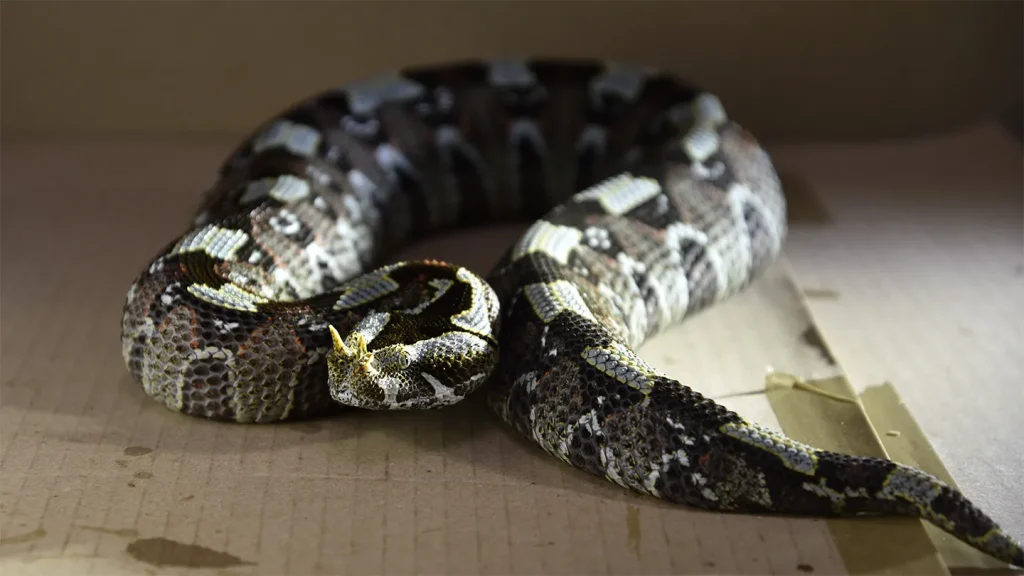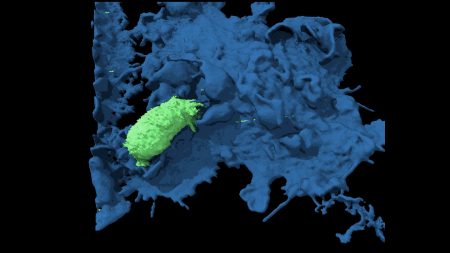The Impressive Speed of Viper Strikes: Nature’s Lightning-Fast Predators
In the world of reptilian predators, vipers reign supreme when it comes to attack speed. A fascinating new study published on October 23 in the Journal of Experimental Biology has revealed that vipers possess the fastest strikes among venomous snakes, with some species achieving astonishing velocities that make them the true sprinters of the snake world.
The research, which compared 36 venomous snakes from three different families, found that the terciopelo (Bothrops asper) – a viper native to regions from eastern Mexico to northern South America – topped the speed charts with an average peak velocity of 3.5 meters per second. This remarkable speed is no accident of evolution but rather a critical adaptation for these ambush predators that primarily feed on mammals. As Alistair Evans, a zoologist from Monash University in Melbourne and one of the study’s researchers, explains: “They are the ones that have to be able to strike as quickly as possible.” The necessity for such speed becomes clear when considering that mammals typically require between 60 to 400 milliseconds to react and jump away from an attack. In this deadly game of predator and prey, milliseconds make the difference between a successful hunt and a missed meal.
The comprehensive study represents a significant advancement over previous research on snake strike speeds, which often relied on single cameras or low-resolution equipment and focused on just a few species. In contrast, this new investigation included a diverse sample: 31 vipers, four elapids (the family including cobras), and one colubrid (from the largest snake family that includes many common nonvenomous species). Evans and his colleagues employed two high-speed cameras to capture the movements of snakes housed at Venomworld, a Paris-based facility that provides venom for medical and pharmaceutical purposes. The researchers enticed each snake to strike at artificial prey – specifically warmed ballistics gel designed to mimic muscle tissue – allowing precise measurement of their attack velocities.
The results revealed impressive speed variations even within the viper family. The terciopelo, horned pit viper (Protobothrops cornutus), and blunt-nosed viper (Macrovipera lebetina) demonstrated exceptional quickness, with maximum speeds exceeding 3.3 meters per second. Among the elapids, the rough-scaled death adder (Acanthophis rugosus) proved the fastest, striking at 2.2 meters per second – comparable to some of the slower vipers like the eastern rock rattlesnake. The mangrove snake (Boiga dendrophila), representing the colubrid family in the study, registered a slightly lower but still impressive 1.8 meters per second. Interestingly, the research also found that larger snakes tend to be faster, similar to how human sprinters with more muscle mass can generate greater speed.
Beyond measuring pure velocity, the high-speed cameras captured fascinating differences in strike mechanics across snake families. Vipers typically deliver their venom through smooth, rapid strikes – a single, decisive attack designed to immobilize prey quickly. Elapids, by contrast, employ a different strategy, biting and squeezing their victims multiple times to ensure envenomation. The study even documented unique attack methods in species like Fischer’s cat snake (Toxicodryas pulverulenta), a colubrid that uses its fangs to create large slashing wounds rather than relying primarily on venom injection.
While this research provides unprecedented insights into snake strike speeds, the researchers acknowledge certain limitations in their sample. The study was heavily weighted toward vipers due to the composition of Venomworld’s collection. Evans notes that elapids are approximately as diverse as vipers, while colubrids represent an even larger group. This suggests exciting possibilities for future research, as undiscovered speed champions may be hiding among these less-studied families. The variation documented so far indicates that evolutionary pressures have shaped strike velocity differently across snake species, likely reflecting their diverse hunting strategies, preferred prey, and environmental niches.
The lightning-fast strikes of vipers represent a remarkable evolutionary solution to the challenges of predation. Through millions of years of adaptation, these snakes have developed the perfect balance of speed, precision, and venom delivery systems. As this groundbreaking research continues to expand our understanding of these fascinating predators, it reminds us of the extraordinary ways that nature has fine-tuned its creatures for survival in their respective ecological roles. The viper’s strike – a blur of motion too fast for human eyes to follow – stands as a testament to the remarkable biomechanical achievements possible through natural selection.














